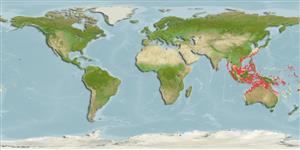>
Gobiiformes (Gobies) >
Gobiidae (Gobies) > Gobiinae
Etymology: Priolepis: Greek, prio = to saw + Greek,lepis = scale (Ref. 45335).
More on author: Weber.
Environment: milieu / climate zone / depth range / distribution range
Écologie
marin démersal; profondeur 45 - 114 m (Ref. 85603). Tropical
Indo-West Pacific: Thailand (Gulf of Thailand) Australia (WA to NT, Arafura Sea), Indonesia (New Guinea), and the Philippines (Samar Sea); probably widespread. First record from Myanmar, Andaman Sea (Ref. 126003).
Taille / Poids / Âge
Maturity: Lm ? range ? - ? cm
Max length : 3.4 cm SL mâle / non sexé; (Ref. 85603)
Description synthétique
Clés d'identification | Morphologie | Morphométrie
Épines dorsales (Total) : 7; Rayons mous dorsaux (Total) : 10; Épines anales: 1; Rayons mous anaux: 8. This species is distinguished by the following characters: interorbital broad, with a slight depression between eyes; predorsal scales covered with ctenoid scales to above mideye, and a small naked patch immediately before first dorsal fin; scales absent immediately behind eye before transverse postocular papilla row; prepelvic area partly scaled immediately before pelvic origin, in 2-8 rows; usually no opercular scales, but rarely 1-5 small scales dorsally; no scales on; usually D2 I,10, A I,8, pectoral rays 19; transverse pattern of sensory papilla rows on cheek; pelvic fins connected to form a plate, but no interspinal membrane, the fifth ray with multiple branches, length about 75-80% of length of fourth ray; head and body brown with a distinct large black blotch at anterior base of first dorsal fin, and in life, head and body with very thin blue bands; no bands dorsally on caudal fin; mouth very oblique, jaws form an angle for 55°-60° with body axis (Ref. 85603).
Inhabits reef crevices (Ref. 90102).
Life cycle and mating behavior
Maturité | Reproduction | Frai | Œufs | Fécondité | Larves
Hoese, D.F. and H.K. Larson, 2010. Description of two new species of the genus Priolepis from the Indo-Pacific with redescription of Priolepis profunda and Priolepis psygmophilia. Ichthyol. Res. 57(3):367-372. (Ref. 85603)
Statut dans la liste rouge de l'IUCN (Ref. 130435: Version 2024-2)
Menace pour l'homme
Harmless
Utilisations par l'homme
Outils
Articles particuliers
Télécharger en XML
Sources Internet
Estimates based on models
Preferred temperature (Ref.
123201): 23.2 - 28.2, mean 27.1 °C (based on 298 cells).
Phylogenetic diversity index (Ref.
82804): PD
50 = 0.5000 [Uniqueness, from 0.5 = low to 2.0 = high].
Bayesian length-weight: a=0.01023 (0.00477 - 0.02194), b=3.01 (2.83 - 3.19), in cm total length, based on LWR estimates for this (Sub)family-body shape (Ref.
93245).
Niveau trophique (Ref.
69278): 3.1 ±0.3 se; based on size and trophs of closest relatives
Résilience (Ref.
120179): Haut, temps minimum de doublement de population inférieur à 15 mois (Preliminary K or Fecundity.).
Fishing Vulnerability (Ref.
59153): Low vulnerability (10 of 100).
